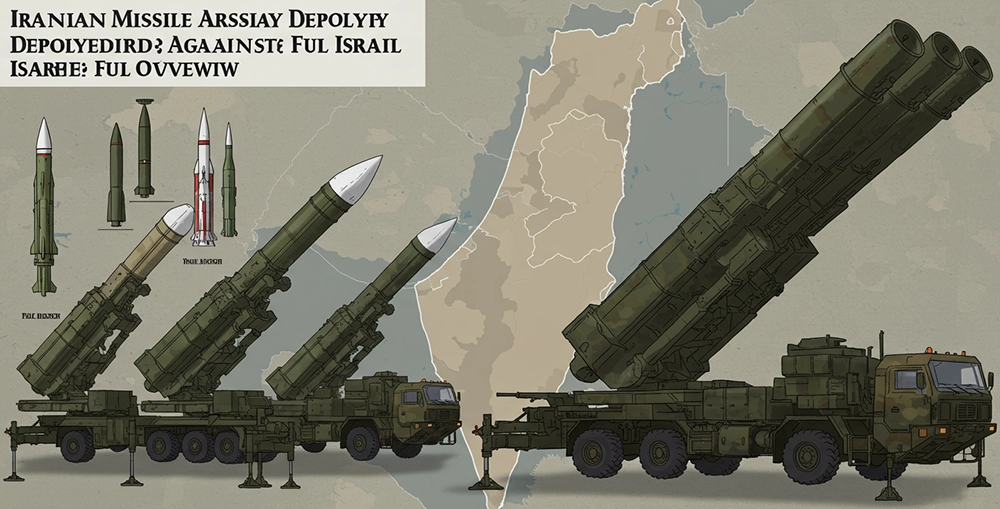
Iranian Missile Arsenal Deployed Against Israel: Full Overview
In the latest escalation of tensions between Iran and Israel, Tehran unleashed a diverse arsenal of ballistic and cruise missiles against Israeli targets. This marked one of the largest and most sophisticated missile assaults in recent Middle Eastern conflict history.
Iran's missile stockpile is among the most varied in the region, designed to overwhelm multi-layered defense systems like Israel’s Iron Dome, David's Sling, and Arrow 3. The recent attack showcased several types of missiles, each serving distinct roles in the offensive strategy.
🚀 Key Iranian Missile Types Used Against Israel
1. Fattah-1 & Fattah-2 (Hypersonic Missiles)
-
Type: Medium-Range Hypersonic Ballistic Missiles (MRBM)
-
Range: ~1,400 km
-
Notable Feature:
-
First-ever hypersonic missiles used in combat against Israel.
-
Equipped with maneuverable re-entry vehicles (MaRV) designed to evade interception.
-
Speed: Up to Mach 13–20 (for Fattah-2), capable of sudden trajectory changes mid-flight.
-
2. Kheibar Shekan (Break the Fortress)
-
Type: Solid-fuel MRBM
-
Range: ~1,200–1,450 km
-
Specialty: Terminal-phase maneuvering to dodge missile defenses; reportedly struck key Israeli military bases including Nevatim Airbase during the April 2025 attacks.
3. Ghadr-110 (Qadr-1)
-
Type: Liquid/Solid Hybrid MRBM
-
Range: ~1,600–2,000 km
-
Description:
-
Upgraded version of the Shahab-3, this missile boasts improved accuracy (~30 meters CEP) and reliability.
-
Previously used in regional conflicts; part of the missile barrage directed toward central and southern Israel.
-
4. Emad
-
Type: Precision-Guided MRBM
-
Range: ~1,500–2,000 km
-
Features:
-
Highly accurate with an estimated circular error probable (CEP) of 10–50 meters.
-
Equipped with maneuverable warheads to improve penetration of advanced missile defense systems like Arrow 3.
-
5. Shahab-3
-
Type: Liquid-Fuel MRBM
-
Range: ~1,300–2,000 km
-
Description:
-
The foundation of Iran’s medium-range ballistic missile force, operational since 2003.
-
Used primarily against distant military installations and strategic infrastructure.
-
6. Sejjil
-
Type: Solid-Fuel MRBM
-
Range: ~2,000–2,500 km
-
Highlights:
-
High accuracy (~50 meters CEP)
-
Replaces older Shahab models with solid-fuel technology for rapid deployment.
-
Difficult for radars to track due to short preparation time.
-
7. Zolfaghar
-
Type: Short-Range Ballistic Missile (SRBM)
-
Range: ~700 km
-
Purpose:
-
Deployed for strikes on northern Israel or nearby targets.
-
Operational since 2017 with reliable solid-fuel engines for quick launch cycles.
-
8. Qiam-1
-
Type: Liquid-Fuel SRBM
-
Range: ~750–800 km
-
Details:
-
Wingless design reduces radar signature.
-
Improved guidance system over earlier Scud derivatives.
-
Used in both past regional conflicts and the 2025 operation.
-
9. Paveh (Cruise Missile)
-
Type: Long-Range Cruise Missile
-
Range: ~1,650 km
-
Capability:
-
Networked, smart missile capable of group attack strategies.
-
Low flight altitude to evade detection.
-
10. Haj Qasem
-
Type: Solid/Liquid Hybrid MRBM
-
Range: ~1,400 km
-
Feature:
-
Reportedly reaches speeds up to Mach 12.
-
Named after slain General Qasem Soleimani, the missile symbolizes Iran’s long-range precision strike ambitions.
-
11. Fateh-110
-
Type: SRBM
-
Range: ~200–300 km
-
Role:
-
Rapidly deployable, designed for close proximity attacks to saturate missile defense systems.
-
Accurate enough for use against military infrastructure within reachable zones.
-
⚠️ Challenges for Israel’s Defense Systems:
Despite Israel’s high interception success (80–90%), Iranian missiles presented unique difficulties:
-
Hypersonic maneuverability (Fattah series) complicates trajectory prediction.
-
Saturation attack strategy strained Iron Dome and Arrow batteries.
-
Cruise missile low-altitude flight paths (Paveh) aimed to evade radar coverage.
Strategic Conclusion:
Iran’s multi-layered missile capability—from hypersonic to cruise to SRBM/MRBM—represents a significant challenge to Israel’s layered defense shield. As Tehran deploys more advanced missiles with increased speed, maneuverability, and precision, Israel’s defense doctrine may need to evolve, possibly incorporating laser systems and space-based detection platforms.